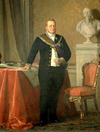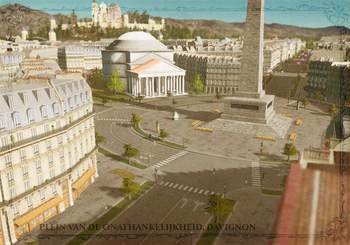Adolf Perrier: Difference between revisions
mNo edit summary |
No edit summary |
||
| Line 2: | Line 2: | ||
{{People| | {{People| | ||
fullname = Adolf Lucas B. Perrier| | fullname = Adolf Lucas B. Perrier| | ||
aka = The Architect of | aka = The Architect of Sizhecheng| | ||
image = Adolf Perrier.png| | image = Adolf Perrier.png| | ||
gender = Male| | gender = Male| | ||
| Line 17: | Line 17: | ||
deathdate = / | | deathdate = / | | ||
deathplace = | | deathplace = | | ||
residence = [[Rudolfsboulevard]], [[ | residence = [[Rudolfsboulevard]], [[Sizhecheng]]| | ||
nationality = [[Batavian]]| | nationality = [[Batavian]]| | ||
allegiance = | | allegiance = | | ||
| Line 23: | Line 23: | ||
}} | }} | ||
'''Adolf Lucas B. Perrier''', commonly known as '''Adolf Perrier''' (1624 - ... AN), was an important [[Batavia]]n architect who was chosen by | '''Adolf Lucas B. Perrier''', commonly known as '''Adolf Perrier''' (1624 - ... AN), was an important [[Jingdao]]ese-[[Batavia]]n architect who was chosen by [[Diwang]] [[Zhang San]] to carry out a massive urban renewal program. During the Jingdaoese protection of [[Tianhoucheng]], he studied at the '''Julius Civilis University'''. The old city of [[Sizhecheng]] had throughout the years grown into a mix of monuments and slums. The picturesque streets of the city had, halfway through the 17th century, become epicentres of poverty and diseases. The Geming War had brought violence to the streets of the regional capital. The attempts to combat the situation were hindered by a lack of funds, and [[Jingdao]]ese officials clashed with unwillingness of the locals to move "an inch from their home". | ||
[[File:Davignon Onafhankelijkheidsplein.png|thumb|left|350px|Adolf Perrier redesigned the ''Plein van | [[File:Davignon Onafhankelijkheidsplein.png|thumb|left|350px|Adolf Perrier redesigned the ''Plein van Vereniging'' (Square of Unity). Old buildings were torn down, while the Old Royal Mint was repaired, to make place for the new square. An obelisk was erected in the centre, to symbolise the city's revival.]] | ||
The | The [[War of Lost Brothers]] brought little changes, and the city escaped the war relatively unharmed. Only in 1669 AN, after a dreadful fire which engulfed large city districts, the local Vice-Roy of [[Jinkeai]] received the funds and necessary support (aided by his personal influence and family fortune) to hire Adolf Perrier. The plans of Perrier were revolutionary: the old, medieval city (which was mostly in ashes) would make room for large boulevards, parks for both the commoners as landowners and several new monuments and constructions in Batavian Renaissance style (inspired by [[Paleys Raiselle]] in Batavia). | ||
[[category: | [[category:Jinkeai]] | ||
[[category:Jingdao]] | |||
Latest revision as of 17:24, 27 May 2019
| Adolf Perrier | |
 | |
| Full name | Adolf Lucas B. Perrier |
|---|---|
| AKA | The Architect of Sizhecheng |
| Physical information | |
| Species | Human |
| Gender | Male |
| Biographical information | |
| Date of birth | 1624 AN |
| Date of death | / |
| Residence(s) | Rudolfsboulevard, Sizhecheng |
| Nationality | Batavian |
| Occupation | Official |
Adolf Lucas B. Perrier, commonly known as Adolf Perrier (1624 - ... AN), was an important Jingdaoese-Batavian architect who was chosen by Diwang Zhang San to carry out a massive urban renewal program. During the Jingdaoese protection of Tianhoucheng, he studied at the Julius Civilis University. The old city of Sizhecheng had throughout the years grown into a mix of monuments and slums. The picturesque streets of the city had, halfway through the 17th century, become epicentres of poverty and diseases. The Geming War had brought violence to the streets of the regional capital. The attempts to combat the situation were hindered by a lack of funds, and Jingdaoese officials clashed with unwillingness of the locals to move "an inch from their home".
The War of Lost Brothers brought little changes, and the city escaped the war relatively unharmed. Only in 1669 AN, after a dreadful fire which engulfed large city districts, the local Vice-Roy of Jinkeai received the funds and necessary support (aided by his personal influence and family fortune) to hire Adolf Perrier. The plans of Perrier were revolutionary: the old, medieval city (which was mostly in ashes) would make room for large boulevards, parks for both the commoners as landowners and several new monuments and constructions in Batavian Renaissance style (inspired by Paleys Raiselle in Batavia).
